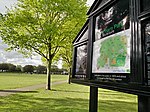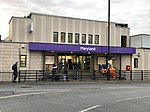St Matthew's Church, West Ham
1891 establishments in England1896 establishments in England19th-century Church of England church buildingsChurch of England church buildings in West HamLondon church stubs ... and 1 more
West Ham

St Matthew's Church is a Church of England church on Dyson Road in West Ham, east London. It originated in 1891 as a mission of All Saints Church, West Ham, designed to serve the area between West Ham Park and Romford Road. A permanent building was put up in 1896 and a separate parish formed the following year. It opened a mission of its own around 1900 in Vicarage Lane, which was destroyed by the London Blitz.
Excerpt from the Wikipedia article St Matthew's Church, West Ham (License: CC BY-SA 3.0, Authors, Images).St Matthew's Church, West Ham
Vaughan Road, London Maryland (London Borough of Newham)
Geographical coordinates (GPS) Address External links Nearby Places Show on map
Geographical coordinates (GPS)
| Latitude | Longitude |
|---|---|
| N 51.5432 ° | E 0.0146 ° |
Address
St Matthews Church
Vaughan Road
E15 4AA London, Maryland (London Borough of Newham)
England, United Kingdom
Open on Google Maps






